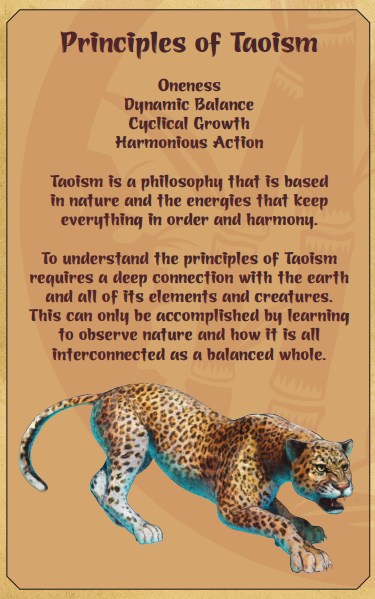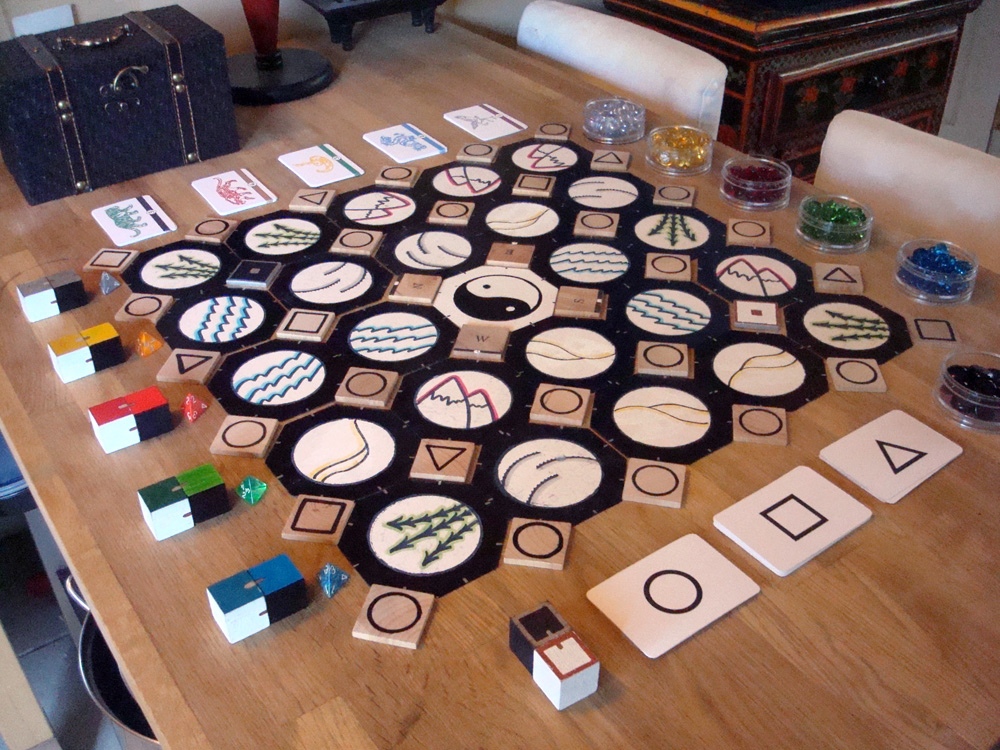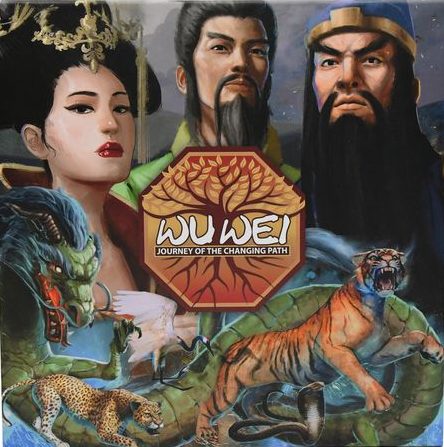As part of our December Spotlight on Wu Wei, we strive to inform readers of little extra tidbits surrounding the game. Games are made by people, and one of those tidbits we enjoy is learning a little bit more about the people behind them. Some designers shy away from the public stage, while others enjoy being front and center.
For Justin Waggle, owner of Gray Wolf Games and designer of Wu Wei: Journey of the Changing Path, talking about the game is all he’d rather be doing right now. As is often the case for inaugural designers, Wu Wei has had a long road to becoming the real deal, including several years in design, nearly as many in playtesting, and undergoing at least one name change in the process. Which, given the game’s abstract nature, really says something about how much the project means to him. The last couple years have been a personal mission to simply bring the Wu Wei game to life, and to some extents it’s been all-consuming in terms of his board game discussion. Now, on the doorstep of it finally being done, it’s almost a little jarring for him to switch and talk about it in present versus future terms. Yet his enthusiasm hasn’t shifted at all.
We in fact came across Wu Wei a ways back by sheer coincidence, though at the time we weren’t even sure what we were looking at. Wu Wei is predominantly abstract in how it looks, but even then we were able to realize how much effort Justin was putting into giving each decision, each piece, each movement, a thematic purpose. Wu Wei isn’t just a game about moving pieces along a board: how and why those pieces move are inextricably linked to the game’s deeper concepts. On the surface Wu Wei is just blocks on a board, but its underlying premise revolves around the philosophical aspects of martial arts training, Taoism, and balance. All at once. And while it all works, we admit it can be a little tricky to explain at times.
So we’ll let Justin do it.
After a series of back and forths (it is the holiday season after all), we were able to grab Justin for a few moments of his time where he was able to both explain his thought processes for putting such a unique and intricately designed game together, and gush about what a long, strange road it’s been. As most first-timers often do. But we love hearing about those stories, and we we hope that you do too.
Enjoy!
Round One Questions
CR: What was your Gateway Game?
I was introduced to the world of board games by my grandfather at an early age. The first game that really captured my attention was Wiz-War by Tom Jolly. It’s funny and strategic and the perfect length. I actually met Tom Jolly at a convention and had him sign my original copy!
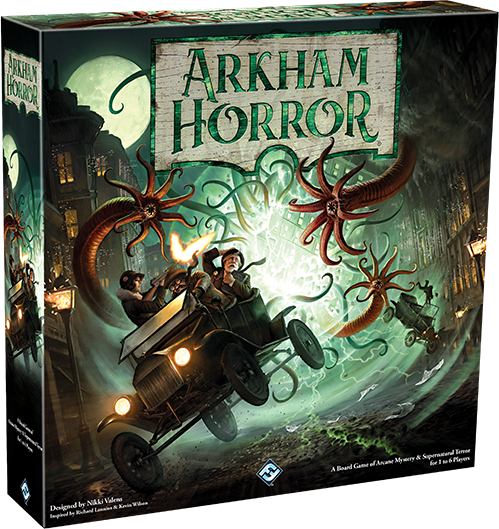
CR: What was the last game you really enjoyed playing (besides Wu Wei)?
I just played the third edition of Arkham Horror and it was fantastic. I really enjoyed the immersive quality of the scenario I played, the updated game mechanics, and the shortened game length. I was a fan of the second edition, but the game length made it so the game only hit my table a couple of times a year. Now I’m excited to play all the new scenarios.
CR: How big is your game collection?
I own around 50 games.
CR: What is your favorite type of game to play?
I like games with interesting social dynamics and my guilty pleasure is the betrayal mechanic (I’m looking at you Smirk & Dagger Games).
CR: How do you feel about Monopoly?
When Monopoly is played correctly it can make for some interesting negotiating between players. Convincing people to give me Baltic and Mediterranean allows me to fulfill my fantasy of becoming a slum lord.
On Wu Wei
CR: Ok, first of all – you have to tell us how you came up with the concept of this game. It’s well-researched and clearly it’s a passion project, so there’s a story here…
I developed an interest in Taoism after reading the Tao of Pooh and the Tao Te Ching. Shortly after moving to Los Angeles, I started taking classes at a school called the Taoist Institute. Little did I know that I would spend the next 10 years there studying Tai Chi Chuan, Kung, Fu, and Qi Gong. I eventually earned my Black Sashes in Kung Fu and Tai Chi and became an instructor. Roughly two years into my studies, I woke up with an idea for a board game. The martial arts journey is a lifelong journey and Wu Wei: Journey of the Changing Path became a sort of prism for my studies.
CR: While definitely abstract in nature, it’s evident a lot of thought went into all the design decisions. Was it hard tying the different game mechanisms to different parts of Tao philosophy?
The concept of Wu Wei (Align with nature. Embrace effortless action. Do without doing.) went into every nook and cranny of the game. It also served as a good reminder when I came across stumbling blocks and frustrations during its creation. It was very important to me that the game mechanics reflected the nature of this subtle influence. In addition to Taoist philosophy, the resulting efficiency of movement that comes when you are in the flow is a direct reflection of my martial arts training. When you are facing an opponent, you always want to be at the right place at the right time. If your movements are predictable then your opponent can anticipate your next move. If you can change your rhythm and vary your attack, you will surprise your opponent and cultivate greater speed while conserving energy and maximizing efficiency. My teacher (Sijo Carl Totton) would often shout out, “What is Kung Fu?!” in the middle of a grueling class and we would respond, “Hard work!”. So…yeah, I’m not gonna lie. It was hard!
CR: Did you have any concerns about injecting that many ideas into a single game and players’ ability to recognize those aspects therein?
I actually developed the highest level of the game first (The Emperor Level). After testing the game I realized that the learning curve was pretty high. Mirroring Sijo Carl Totton’s teaching style, I scaled it back (twice) to create an intro level and what is considered the standard level of play. Consequently, like martial arts and Taoist philosophy, this game is layered with multiple lessons above and below the surface. I feel like I’m still learning lessons from the game as I continue to play and as I get better at discussing its various influences.
CR: The game goes so far as to be recognized by the Martial Arts History Museum. What was it about this game that caught their attention specifically?
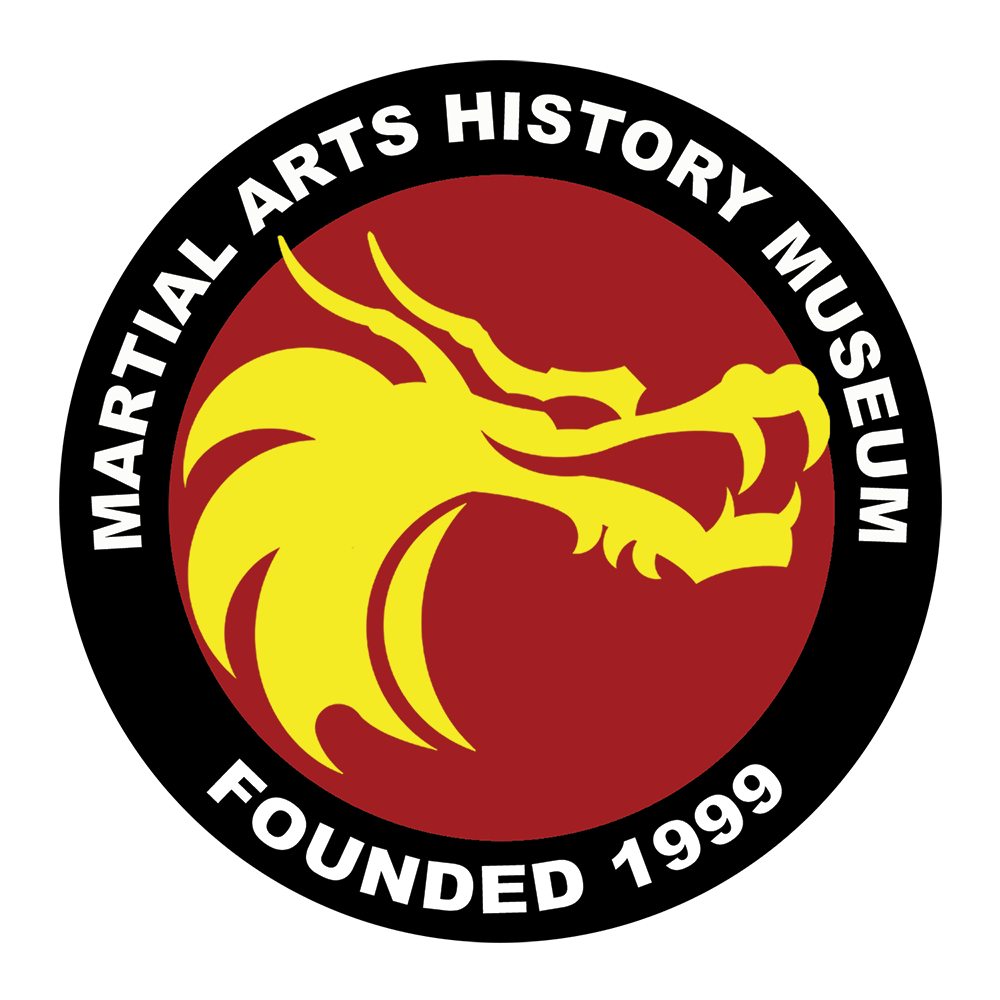 I worked very hard to make Wu Wei as inclusive as possible. It doesn’t dwell on one style versus another, and there are no crests from martial arts schools included in the rule book. Rather, it’s a game about martial arts concepts. It’s also a game about preserving and transmitting the martial arts to future generations. I think the message of the game and the mission of the museum really fell in line. As far as I know, there aren’t any other games out there that have taken this approach with respect to martial arts and I think this was noted by the museum’s founder Michael Matsuda.
I worked very hard to make Wu Wei as inclusive as possible. It doesn’t dwell on one style versus another, and there are no crests from martial arts schools included in the rule book. Rather, it’s a game about martial arts concepts. It’s also a game about preserving and transmitting the martial arts to future generations. I think the message of the game and the mission of the museum really fell in line. As far as I know, there aren’t any other games out there that have taken this approach with respect to martial arts and I think this was noted by the museum’s founder Michael Matsuda.
CR: Wu Wei used to be known as Lineage. What prompted the name change, and does Wu Wei better reflect what the game is trying to convey?
I really liked the name Lineage but it turned out to also be the name of an MMO [massive multiplayer online] game and was consequently trademarked in several categories, including board games. But this became another great opportunity to yield and overcome. Wu Wei: Journey of the Changing Path really does serve the central theme of the game much better. As much as evangelism is not a part of Taoism, I feel like popularizing the concept of Wu Wei can only serve to make the world a better place, so I’m happy the name changed.
CR: Abstract games can be particularly challenging to run Kickstarter campaigns for. Did you run into that with yours, or were there other factors that had a bigger impact on it?
I’ve noticed that games that feature miniatures or worker placement mechanics have a lower threshold for acceptance by the board game community. I think there’s a certain confidence that comes from familiarity. It’s really hard to invest your time in a game when you aren’t sure if you will like it. My first Kickstarter campaign failed spectacularly, but I’m grateful that it did. The whole experience and a well-timed application led me to a job with Panda Game Manufacturing. I worked for Panda for three years before leaving the company to pursue Gray Wolf Games and my second Kickstarter campaign. Interestingly, despite improvements to the game and all my experience and contacts in the industry, I still made almost exactly the same amount the second time. Thankfully I lowered my total goal and strapped in to make up the rest of the money with my work as a web developer. I couldn’t imagine the final product any other way and I wasn’t willing to compromise. I can’t say I recommend my approach, but sometimes you just have to fulfill your vision.
CR: The game is stated to be capable of played with three different difficulty tiers, with the highest adding in asymmetric gameplay in the form of the Emperor whose goals often run counter to the other players. You mentioned the Emperor Level earlier and we wanted to circle back to that.
The Emperor Level was actually the first level I created. It’s really easy to create a complicated board game and very hard to kill your darling ideas. Most of my work over the eight years this game took to develop was simplifying and streamlining it so that folks could grasp the basic mechanics before hitting players with elusive masters and ultimately the dominating power of the Emperor, Empress, and the Generals. There’s this notion of unlearning or returning to the uncarved block in Taoism. By embodying raw uninterrupted potential, you can take more natural and spontaneous actions. It’s hard when you have to sacrifice a clever idea but ultimately rewarding when you get more natural and spontaneous play as a result.
CR: Finally, outside of the normal learning experiences that go into designing and publishing your game, what would you say is the thing you learned most about yourself throughout its lengthy journey? Be honest…
I learned that I have a lot more patience than I ever realized. I hoped every year that went by was the last year. I hoped every one of the over 50 iterations of the rules was the last. Designing Wu Wei was simultaneously comforting and infuriating. I was taking an internal and external journey with a game about journeys. It was totally meta. I learned about committing to something and I learned how much things take and I learned what it means to sacrifice to achieve your goals. Ultimately, I learned what I was capable of achieving when I embraced my own power instead of hiding from it. Wu Wei: Journey of the Changing Path is the chronicle of my journey but it’s also an invitation for other people to embrace their journeys. I’m happy I created the game and forever changed for the better because I did.
Wu Wei is very much a multilayered game. Containing three different difficulty tiers of increasing engagement, a robust solo mode, and more than a few moments when you suddenly understand why certain elements of the game behave the way they do thanks to an extensive but not overbearing conveyance of martial arts philosophy sprinkled throughout the rulebook, Wu Wei is a game about several different things at once. Yet it’s fairly clear from the onset that it’s not just another faceless abstract. Everything in Wu Wei is there with a purpose. Luckily, the best way to learn about it is to sit down and actually play.
Recognizing that we could fly Justin out to teach you about the many wonderfully interlocking ideas found in Wu Wei, or having you read for three hours on Wikipedia about the basic tenants of various philosophies that have been around for millennia, we thought, hey, maybe we just offer up a copy of the game instead:
Photo Credits: Wu Wei cover and photos by Gray Wolf Games.



